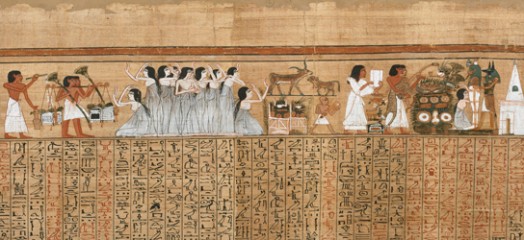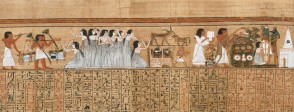
An ancient Egyptian funeral
The Book of the Dead is the modern name for a collection of spells that the ancient Egyptians called ‘The spells for going out by day’. These spells were usually written in hieroglyphs on rolls of papyrus and placed in or near the coffin of the deceased. Some of the spells were to be recited by priests during a person’s mummification and funeral. The rest were a dead person’s guide to surviving in the afterlife. Only the wealthy could afford beautiful illustrated scrolls like this Book of the Dead, made for a high-ranking scribe called Ani, who lived in Thebes (modern Luxor) about 1275 BC. This section of Ani’s Book of the Dead shows his funeral.
Funerals took place once mummification of the body was complete, which could take up to 70 days. If the tomb was not ready, the funeral might have to wait even longer. After the mummy was wrapped, it was placed inside one or more coffins and taken back to the dead person’s home, so the funeral procession could start from there. The procession often had to cross the Nile by boat to a cemetery on the west bank. The coffin was then dragged to the tomb on a sledge drawn by oxen.
The funeral procession
The family walked behind the coffin. Men who were in mourning did not shave and women tore their clothing and put dirt on their heads as a sign of grief. Sometimes professional female mourners were employed to weep and wail. Paintings show them with their eye makeup running down their faces with the tears. Behind the mourners came servants carrying the things that were to be buried with the dead person.
Several kinds of priest took part in the funeral. The most important was the lector-priest, who read the prayers and spells from a scroll. When the procession arrived at the tomb, the coffin was placed upright, supported by a priest dressed as Anubis, the jackal-headed god of cemeteries and embalming. The dead person was addressed as the god Osiris, the first king of Egypt, who was murdered by his brother Seth and became ruler of the Underworld. Two women, usually female relatives, played the roles of Isis and Nephthys kneeling beside the coffin singing funeral songs for the dead person, just as the twin goddesses had sung laments for their dead brother Osiris.
Funeral rites
A series of rituals was then performed by the priests and by the sons of the dead person. The most important of these were the Opening of the Mouth ritual and the offering ritual. The Opening of the Mouth ritual was supposed to restore the mummy’s senses, so that it could breathe, see and hear again. During this rite, spells were read and the mummy’s mouth, nose and eyes were touched with ritual implements to ‘open’ them.
In the offering ritual, a priest recited spells to make sure that the spirit of the dead person would have everything that it needed to survive in the afterlife. As part of this rite, a table of food was offered to the deceased, and a calf was killed and its leg and still-beating heart offered to the dead person to restore their vitality. Once these ceremonies were over, the coffin was placed in the burial chamber and the family held a feast in or near the tomb. Afterwards, the pots they had used during the meal were smashed, and the broken pieces, along with anything else left over from the funeral feast, were buried near the tomb.
The Egyptians did not regard the funeral as a final goodbye. People made regular visits to their family tombs, where parties were held to bring the living and the dead together, and statues of the gods were sometimes carried through the cemeteries to allow the dead to participate in religious festivals. The living believed that their dead loved ones would be able to use the spells in the Book of the Dead to transform themselves into birds in order to visit their families. It was not unusual for families to keep busts of dead relatives in the house to encourage their spirits to visit, and people often left letters to the dead in tombs.
More information
Information on the Opening of the Mouth ritual
http://www.touregypt.net/featurestories/open.htm
Teachers’ resource
British Museum teachers’ resource on the Book of the Dead, with ideas for classroom activities.
http://www.britishmuseum.org/pdf/3665_BOTD_schools_Teachers.pdf
Opening the mouth from the Book of the Dead of Hunefer
http://www.britishmuseum.org/explore/highlights/highlight_objects/aes/p/page_from_the_book_of_the_de-1.aspx
Useful article on shabtis, with text of the shabti spell
http://www.touregypt.net/featurestories/ushabti.htm
Heart scarab
http://www.britishmuseum.org/explore/highlights/highlight_objects/aes/s/steatite_heart_scarab_amulet.aspx
Heart scarab text
http://egyptmanchester.wordpress.com/2012/02/06/texts-in-translation-1-the-heart-scarab-of-na-her-hu-acc-no-5998/
Information on dung beetles
http://www.britishmuseum.org/explore/highlights/articles/e/egyptian_scarabs.aspx
Another scene from Ani’s Book of the Dead
http://www.britishmuseum.org/explore/highlights/highlight_objects/aes/p/book_of_the_dead_of_ani-1.aspx
More information
-
Information on the Opening of the Mouth ritual
Source: touregypt.net
-
Teachers’ resource
British Museum teachers’ resource on the Book of the Dead, with ideas for classroom activities.
Source: britishmuseum.org
-
Opening the mouth from the Book of the Dead of Hunefer
Source: britishmuseum.org
-
Useful article on shabtis, with text of the shabti spell
Source: touregypt.net
-
Heart scarab
Source: britishmuseum.org
-
Heart scarab text
Source: egyptmanchester.wordpress.com
-
Information on dung beetles
Source: britishmuseum.org
-
Another scene from Ani’s Book of the Dead
Source: britishmuseum.org


